South Shore Long Island
a 1970’s childhood
It’s hard to see the true character of one’s surroundings during childhood, when one’s experience of the wider world is limited. For me, the passage of several decades since my 1970s childhood has brought into focus not only the prevailing culture of that time, but also the particular features that made growing up on the south shore of Long Island singular.
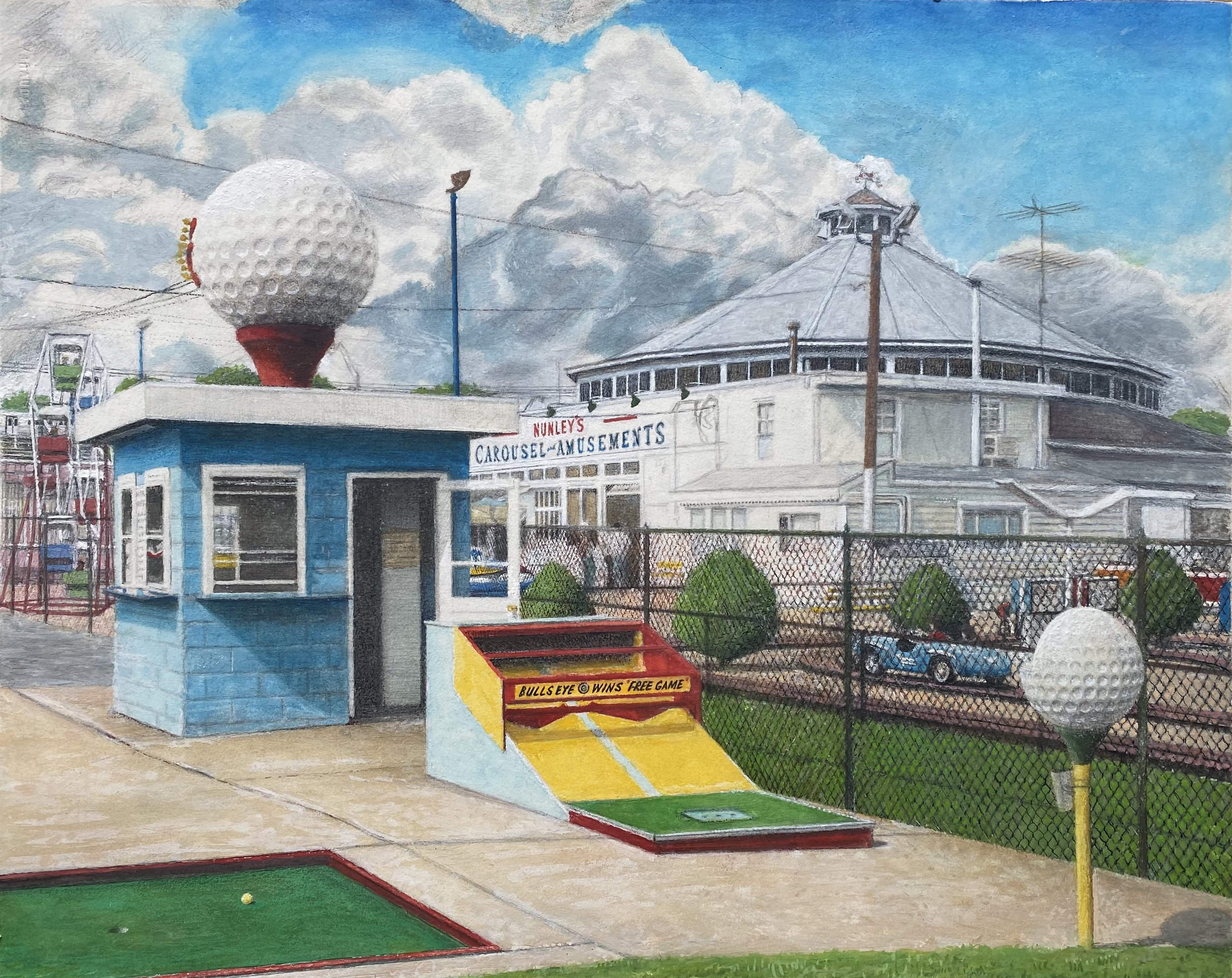
Nunley’s in Baldwin encompassed 20th century leisure. The carousel and pavilion were from Golden City, a closed 1912 Canarsie seaside amusement park! The restaurant opened in 1940, outdoor rides were added in the 1950s, and the mini golf course was built in the 1960s. Until it closed in 1995, up to date arcade games mingled with Skee Ball and vintage attractions.
Somehow there were two worlds always on the outskirts of the atmosphere— New York City to the west, and the sparsely populated farmland to the east. Life seemed poised between these different energies— lots of folks had stories originating in the boroughs, or worked or visited there, and some of the teeming force of the city was evident. But the slower pace of change in rural Long Island provided a kind of ballast, a physical and cultural balance, to one’s sense of place. As a child, I remember field trips to the United Nations, and also to nearby pumpkin or game farms. In Baldwin, my hometown, the occasional deafening low-flying airplane seemed normal, as did undeveloped areas of woods, or the smell of ocean near the southern end.
Proximity to Brooklyn, and the flow of 20th century Brooklynites to suburban Long Island, meant that German, Jewish, and Italian delis would proliferate, that Nathan’s would open a huge satellite branch in Oceanside, and that amusement parks redolent of Coney Island would dot the landscape. Baldwin had such a park, Nunley’s, which opened in 1940 and featured a 1912 Coney Island style carousel. An older and much larger one, Playland Park, had operated at the water’s edge in Freeport until it burned down in the 1930s.
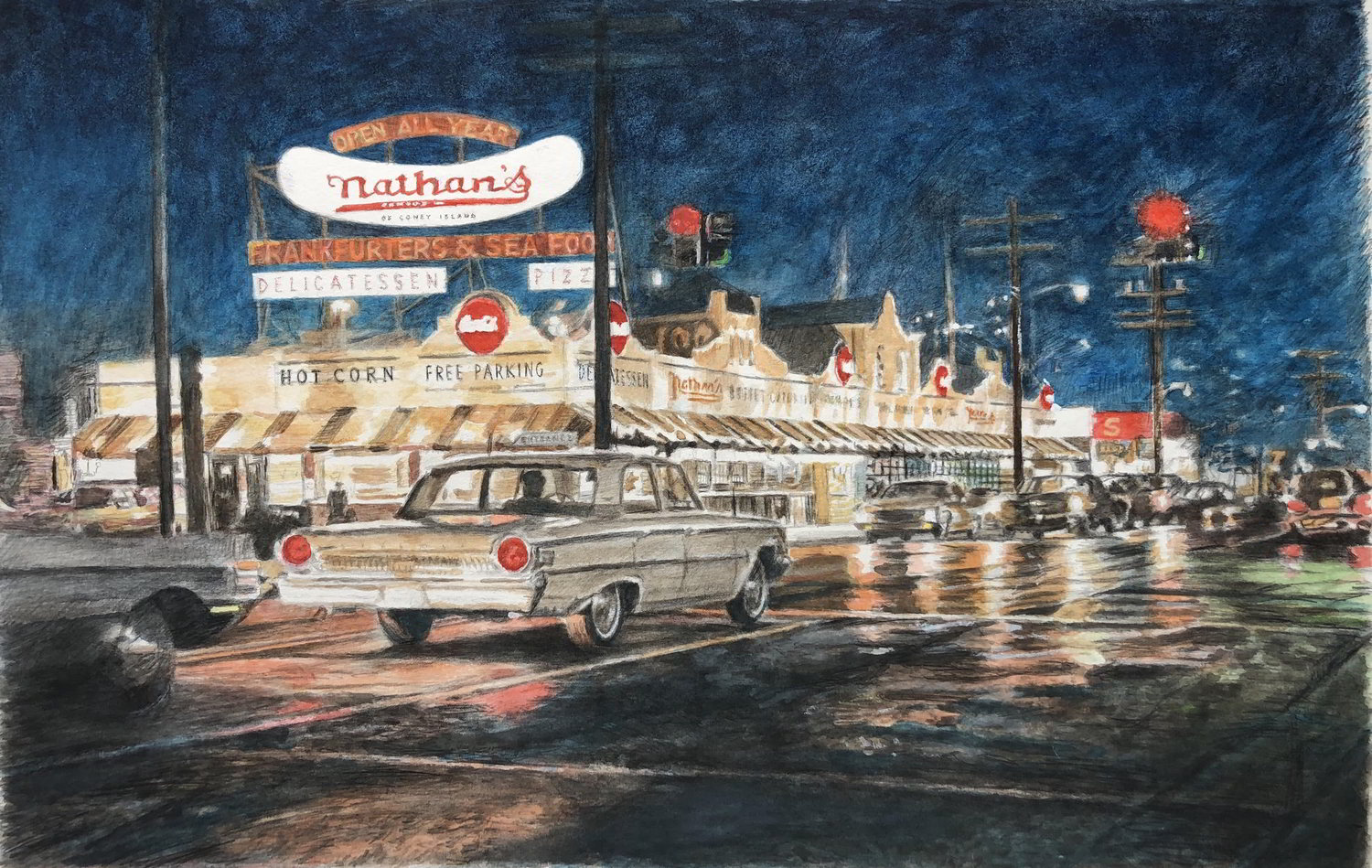
The water, of course, was a major presence. A favorite childhood memory of mine is heading early in the morning to either Point Lookout, Lido, or Jones Beach, stopping at a local bakery to pick up danish, rolls, and bagels, and eating breakfast in view of the ocean well before 9am. Those were epic, full-day experiences, and the pleasures in them were simple but sufficient… learning to ride waves, digging down in the sand to water, deciding how to spend change at the concession stand, while toasting in the sun. Freeport, next to Baldwin, had its Nautical Mile, and picking up bagfuls of steamer clams was as common as picking up milk and eggs at Dairy Barn.
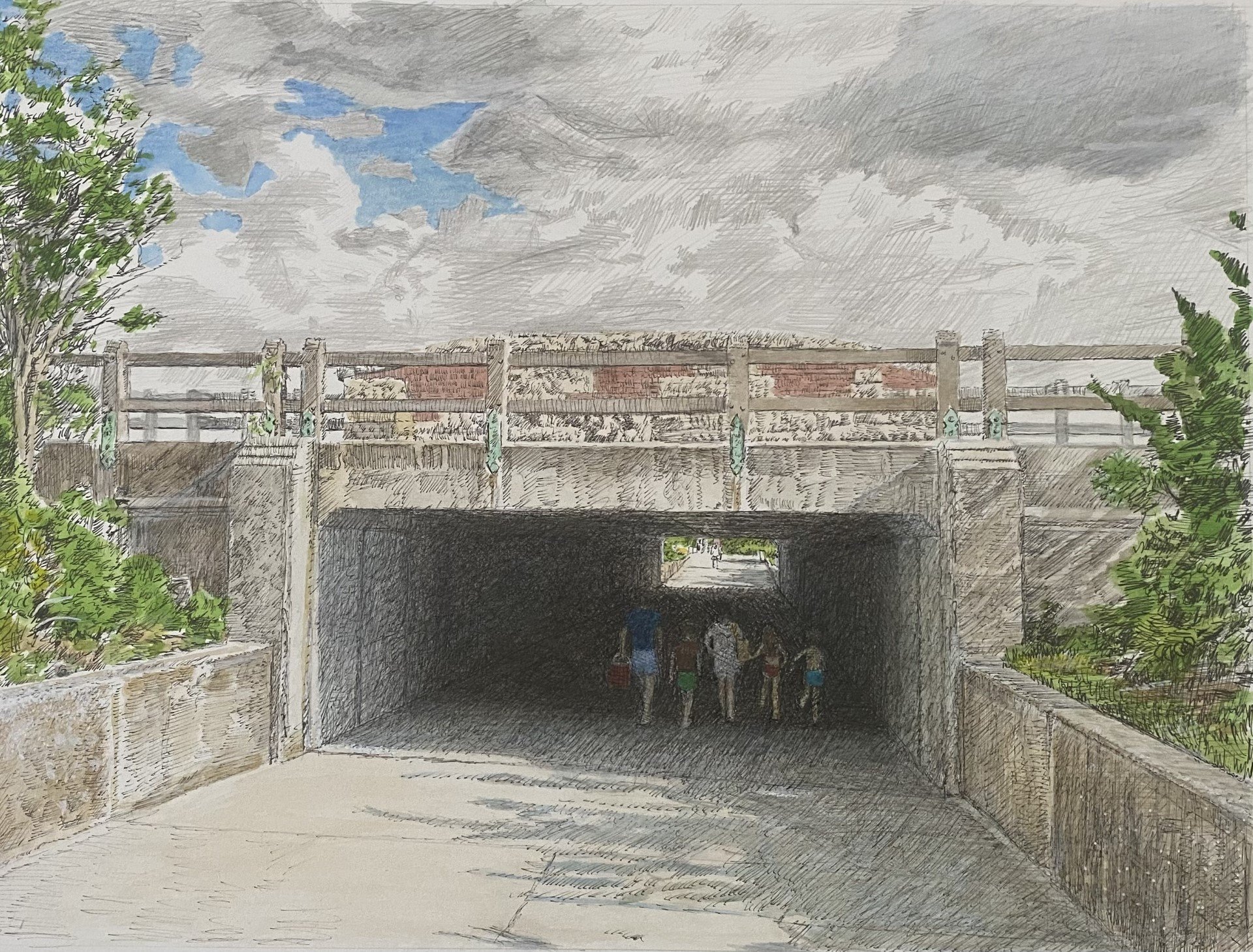
I recall the childhood feeling of lying in bed on summer nights, no school the next morning. Little window fans cutting the humidity, the hint of salt air, drowsily enjoying a comic book by reading lamp, and hearing the resolute, mournful sound of a Long Island Railroad train whistle, seeming to signal even to our quiet street that the business of life was still dependably going on, somewhere at the edge of the world.
Several examples of my artworks of south shore landmarks can be seen below.
Click on image to see full size. Click on title to see print.
My watercolor and ink painting of a Long Island institution, All American Burger, which has operated from the same building under the same family since March, 1963. The “futuristic” building design and neon signs have become beloved landmarks on Merrick Road in Massapequa, and evoke an earlier era.
Each giclee print is one of an edition of 500, printed on archival Hahnemuhle paper, signed and numbered by the artist.
My watercolor and ink painting of a beloved institution, Dairy Barn, a drive-thru convenience store that started in 1961 at a Northport dairy farm, and at its height operated 70 stores around Long Island. The distinctive red silos and split rail fences were a common sight (my hometown had two), and transactions were called out between the driver and clerk. Dairy Barn specialized, naturally, in milk, with distinctive glass bottles that harkened back to milkman days. I remember my mom often stopping there for bread, eggs, milk, and perhaps Entenmann’s or Drake’s cakes, the clerk calling out “Four seventy-two”, and my mom calling back “out of five”. The clerk would hand over a brown paper bag and change in one trip, and off we’d go, with three of us kids in the back. My painting depicts a 1976 scene, with a Monte Carlo, Stingray, and Ford Country Squire visible.
Each giclee print is one of an edition of 500, printed on archival Hahnemuhle paper, signed and numbered by the artist.
This print shows my watercolor and ink painting of the Oak Beach Inn (OBI South). The first of four OBI branches to open across Long Island, it was opened in 1969 in a 1900 waterfront restaurant, and became a popular restaurant and nightclub. Countless patrons from Long Island and beyond remember it for dancing under summer starlight and the drink concocted by a bartender there, the Long Island Iced Tea, in 1975, as well as Sunday brunches by the fire.
Each giclee print is one of an edition of 500, printed on archival Hahnemuhle paper, signed and numbered by the artist.
As a child, on trips to the beach, I used to marvel at the sight of bay houses rising from the wetlands off of the Loop Parkway. Between their intimate relationship with the natural seascape and old world design charms, I felt a pang of longing imagining myself sitting inside their porches, or sleeping in a snug cabin with rain on the roof. Of the hundreds of bay houses built by fishermen and boatmen that stood a century ago, only a few dozen remain.
Each giclee print is one of an edition of 500, printed on archival Hahnemuhle paper, signed and numbered by the artist.
My watercolor and ink painting of a beloved pedestrian underpass at Field 4, Jones Beach. Countless young Long Islanders and visitors to Jones Beach, myself included, took advantage of the acoustics of this beautiful Art Deco tunnel, punctuating our arrival and departure with songs, screams, and whoops. Many feel that this is as essential a part of the Jones Beach experience as spotting the water tower from a distance or strolling the boardwalk. Click on thumbnail to see full image.
Each giclee print is one of an edition of 500, printed on archival Hahnemuhle paper, signed and numbered by the artist.
This watercolor painting depicts the famous Jones Beach Water Tower, often referred to locally as “the Pencil”. Throughout my childhood, the sight of the tower in the distance on Ocean Parkway meant that the beach day had started. The tower was designed in 1930 to resemble the bell tower of St Mark’s basilica in Venice, and at 188 feet, remains one of the most distinctive and beloved structures on Long Island.
Click through thumbnail images to see full painting.
Each giclee print is one of an edition of 250, printed on archival Hahnemuhle paper, signed and numbered by the artist.
My watercolor and ink painting of the famous Pan Am Worldport terminal building, as it looked in 1961, when JFK Airport was still known as Idlewild, or New York International. Pan Am for years seemed like it would always be a part of the cultural landscape, like Dodge cars or Zenith televisions. The building reflects the optimism and industrial supremacy of America at the time, the era of the World’s Fair and the Jetsons. The dramatically modern building, with its unmistakeable “flying saucer” roof, operated from 1960-2013.
Each giclee print is one of an edition of 500, printed on archival Hahnemuhle paper, signed and numbered by the artist.
This print shows my watercolor and ink painting of the Montauk Point Lighthouse, the easternmost point on Long Island. The depiction is based on the area’s appearance in the 1920s, when Turtle Hill, the rocky bluff the lighthouse stands on, was more substantial than today, jutting many more meters into the sea. Click on thumbnail to see full image.
Each giclee print is one of an edition of 500, printed on archival Hahnemuhle paper, signed and numbered by the artist.
My watercolor and ink painting of Jolly Roger/Happyland, the beloved amusement park and restaurant that operated on Hempstead Turnpike from 1951-1978. The park was opened by William Nunley, already known to Long Islanders for his famous Nunley’s Carousel in Baldwin. Jolly Roger restaurant opened in 1952, adjacent to the park, and most people referred to the restaurant and amusement park together as “Jolly Roger’s”.
Each giclee print is one of an edition of 500, printed on archival Hahnemuhle paper, signed and numbered by the artist.
A watercolor painting I made of Nathan’s Famous on Long Beach Rd, Oceanside. The beautiful Spanish style building was originally Roadside Rest, a 1920s restaurant and concert hall featuring big bands. In the 1950s the building was sold to Nathan Handwerker and became the first Nathan’s restaurant to open outside of Coney Island. As Brooklynites migrated out to Long Island, so did their favorite hot dog. I have early childhood memories here of my first ever fried fish sandwich and the best french fries I’ve ever tasted.
There are two sizes: 7 by 11 inches, or 14 by 22 inches, with border. Each giclee print is one of an edition of 250, printed on archival Hahnemuhle paper, signed and numbered by the artist.
Wetson’s was a thriving and beloved burger chain in the NYC area. At its peak in the 1960s, there were 70 branches, mostly on Long Island. It was the first fast food I ever had, at age 4. The building design was inspired by the original McDonald’s, but the orange neon rings on its rooftop were distinctive. Print of my original watercolor. 13 x 18 inches, with border. Click on thumbnail to see full image.
Each giclee print is one of an edition of 250, printed on archival Hahnemuhle paper, signed and numbered by the artist.
My watercolor and ink painting of the Red Store, a beloved deli/grocery store in Oceanside, Long Island, which opened in the 1940s. The small barn-like building was situated in a line of weeping willows, which have long since vanished from the scene. The store itself was a casualty of Hurricane Sandy, and for decades seemed a landmark not only of the town but of an older, sweeter sense of neighborhood.
Each giclee print is one of an edition of 500, printed on archival Hahnemuhle paper, signed and numbered by the artist.
This is a view of the Carvel I grew up with, at 1840 Grand Ave, Baldwin, Long Island (now a Checkers). The trees behind the Carvel store are part of a bucolic, sloping park that had been a lake until it was filled in the early 1900s. My nursery school was next to the park, and at the age of four or so I started delighting in Carvel Brown Bonnets and Parfaits.
Each giclee print is one of an edition of 500, printed on archival Hahnemuhle paper, signed and numbered by the artist.
Every parkway lamp on Long Island was once a “woody”, a distinctive wooden lamppost that gave a sort of visual unity to the place, before they were replaced over the years with metal lampposts. When I was a child there were still many of them all over the place, including on the Southern State Parkway near me growing up, and they are like a primordial memory for me.
Each giclee print is one of an edition of 500, printed on archival Hahnemuhle paper, signed and numbered by the artist.
1960s incarnation of the Nautilus Diner, which has been operating in Massapequa, Long Island since 1963.
Each giclee print is one of an edition of 500, printed on archival Hahnemuhle paper, signed and numbered by the artist.
This print shows my watercolor and ink painting of the Cathedral of the Incarnation in Garden City, NY. The cathedral was built to the memory of Garden City founder A.T. Stewart by his widow Cornelia in 1879, and is the seat of the Episcopal Diocese of Long Island. It remains a glorious example of Gothic Revival style architecture popular at the time, as were Garden City’s sister schools St Paul’s and St Mary’s, which were completed at the same time. I personally associate it with childhood trips to see my grandparents, all of whom lived in Garden City, and the Memorial Day fairs I attended there every year.
Each giclee print is one of an edition of 500, printed on archival Hahnemuhle paper, signed and numbered by the artist.
This print shows my watercolor and ink painting of a rest stop that once stood on the Southern State Parkway, Lakeview, Long Island. Construction began on the Southern State in 1925 under the direction of Robert Moses. The parkways were designed to serve as an atmospheric extension of state parks, with beautiful stone structures and wooden lampposts. One can see a small sign on the lawn for Socony, the precursor to Mobil. These gas stations—and the lanternlike streetlights— fascinated me to no end as a kid. They were all phased out by the late 1980s. This gas station stood to the right of the eastbound side, between exits 17 and 18.
Each giclee print is one of an edition of 500, printed on archival Hahnemuhle paper, signed and numbered by the artist.
This print shows my watercolor and ink painting of a King Kullen supermarket at the southwest corner of Mill Rd and Sunrise Highway. The Long Island supermarket chain, started in Queens 30 years earlier, was a well established stalwart by this time. The design of the store, sign, and cars suggest that this was a kind of peak of suburban lifestyle.
Each giclee print is one of an edition of 100, printed on archival Hahnemuhle paper, signed and numbered by the artist.
This print shows my watercolor and ink painting of a corner of the arcade at Nunley’s Carousel, in my hometown of Baldwin, Long Island. There were arcade games and attractions from several decades there, so it had a museum-like quality during the years that I went and worked there. The machines visible in this painting include a very old version of Grandma’s Predictions and a Williams Mini-Bowl from 1970. When granted a dime, the fortune teller made a slow sweep with her arm as her eyes moved from cards to 8 ball, then dispensed a fortune on a green card, all the way up to Nunley’s closing in 1995.
Each giclee print is one of an edition of 500, printed on archival Hahnemuhle paper, signed and numbered by the artist.
My watercolor and ink painting of the Fire Island Lighthouse on the Great South Bay, built in 1826. One of the more beautiful lighthouses on Long Island, and the one I’ve seen the most in my lifetime, by far.
Each giclee print is one of an edition of 500, printed on archival Hahnemuhle paper, signed and numbered by the artist.
My painting of the famous duck building in Flanders, Long Island. Built by a Riverhead duck farmer in 1931 after a trip to Los Angeles, it originally sold roast ducks on a main street before being moved to the farm itself. The Big Duck is a symbol of the area’s agrarian roots, and also of the architectural whimsy of the era.
Each giclee print is one of an edition of 500, printed on archival Hahnemuhle paper, signed and numbered by the artist.
This print shows my watercolor and ink painting of Long Island institution Umberto’s Restaurant and Pizzeria, which has operated from the same building under the same family since 1965. Like Umberto’s, I was born in New Hyde Park.
Each giclee print is one of an edition of 500, printed on archival Hahnemuhle paper, signed and numbered by the artist.
Point Lookout Beach, just west of Jones Beach, is a small Town of Hempstead Park, where I did much of my beach going throughout childhood. This version of it was built in the late 1960s and lasted about 30 years, and is the iteration I know best. The best days spent here started in the early morning, the ocean providing a soundtrack to our breakfast, and lasted until dinner time. Cookouts, the playground, sandcastles, and a Good Humor chocolate eclair from the concession stand. Also known as heaven.
Each giclee print is one of an edition of 500, printed on archival Hahnemuhle paper, signed and numbered by the artist.
Mid 1960s image of Shea Stadium, where I saw my first day game in 1976. The blue and orange squares were distinctive, and must have seemed the hight of “mod” when new. The place seems mythological now, the first home of the Mets, the site of their “miracle” year, 1969 (also the home field in the Jets’ miracle year of 1969), and the site of the Beatles’ groundbreaking 1965 concert.
Each giclee print is one of an edition of 500, printed on archival Hahnemuhle paper, signed and numbered by the artist.
1970s incarnation of the Shipwreck Diner, which has been operating in Northport, Long Island for more than a century. The Shipwreck, built from a train dining car and originally called the Northport Diner, was wheeled on trolley tracks into its current location in 1924.
Each giclee print is one of an edition of 500, printed on archival Hahnemuhle paper, signed and numbered by the artist.







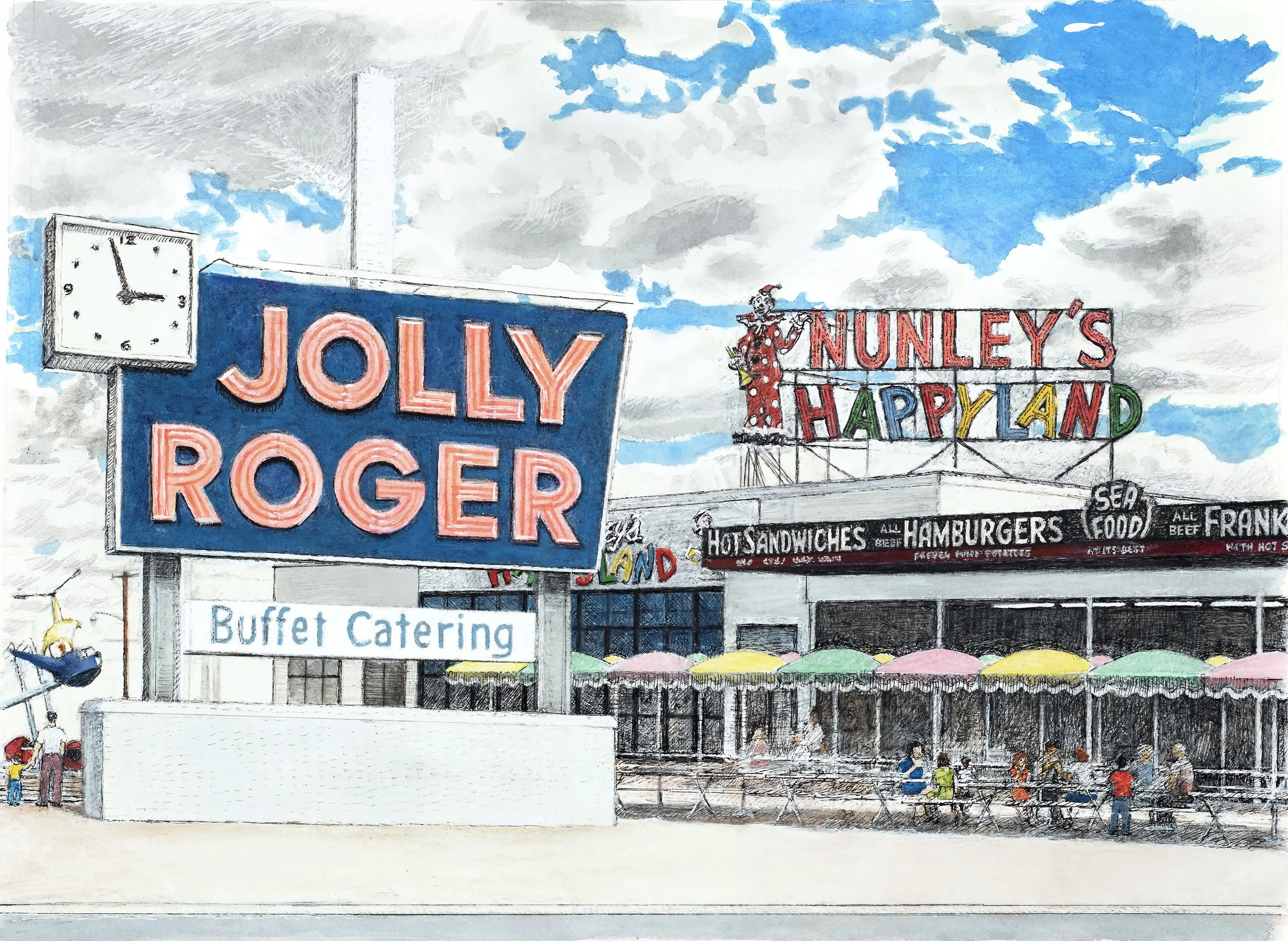














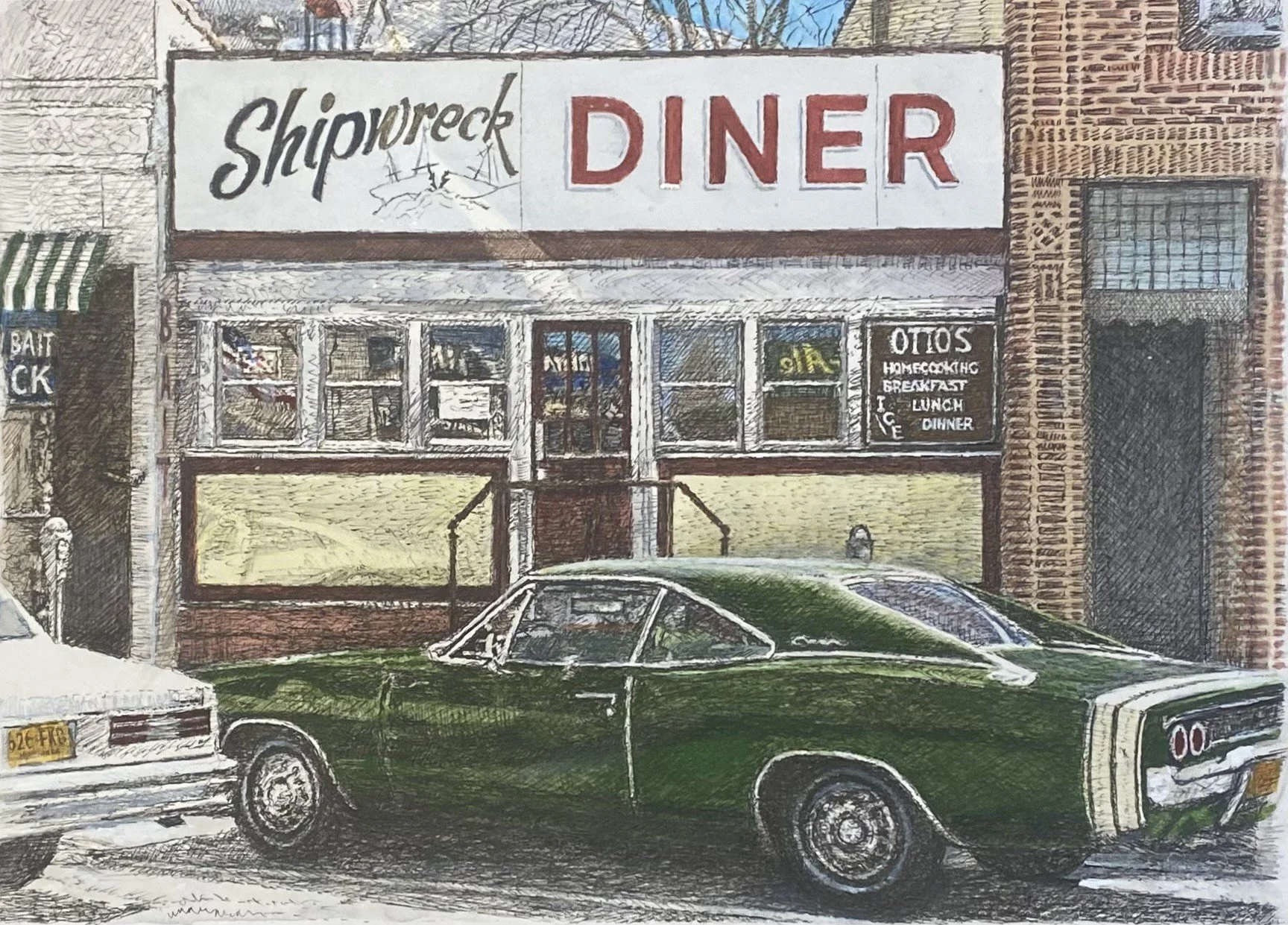
A watercolor painting I made of Nunley’s Carousel, as it looked in Baldwin, Long Island, my hometown, around 1970. The view from the parking lot, when the ferris wheel had six colors, rather than just three. The cars in the parking lot resemble the children’s car rides in the park. 14 by 18 inches, with border. Click on thumbnail to see full image.
Each giclee print is one of an edition of 250, printed on archival Hahnemuhle paper, signed and numbered by the artist.